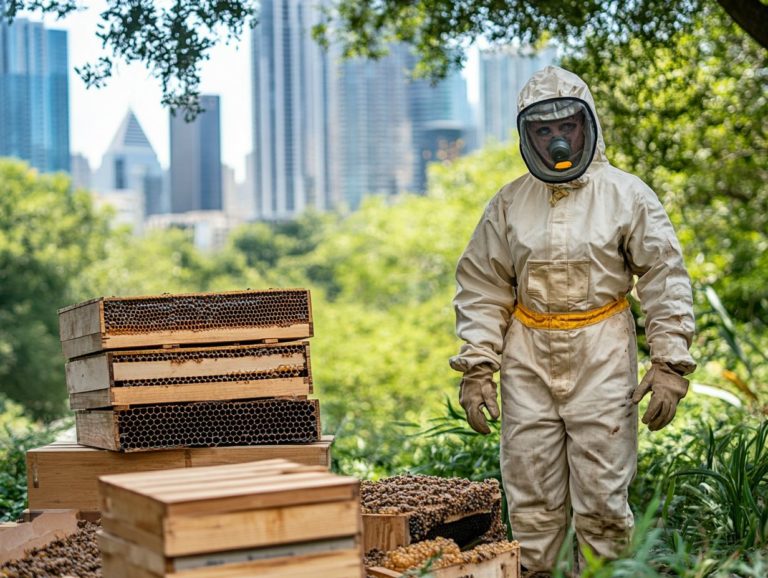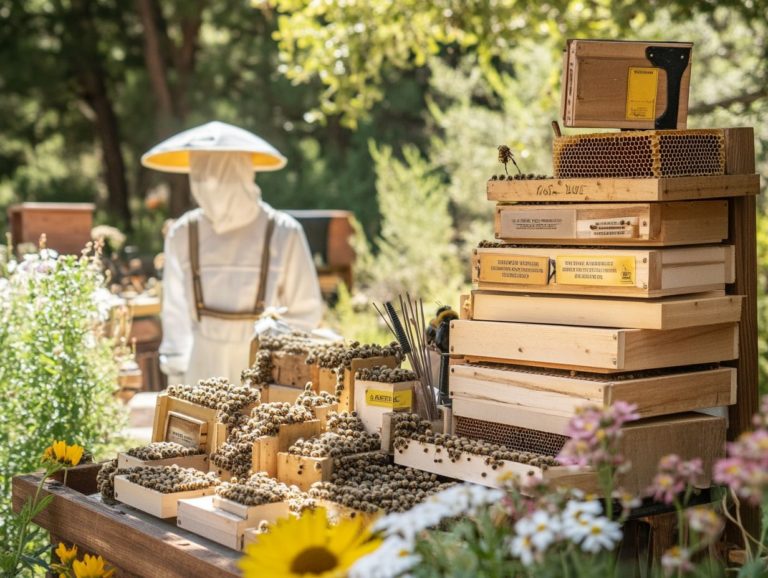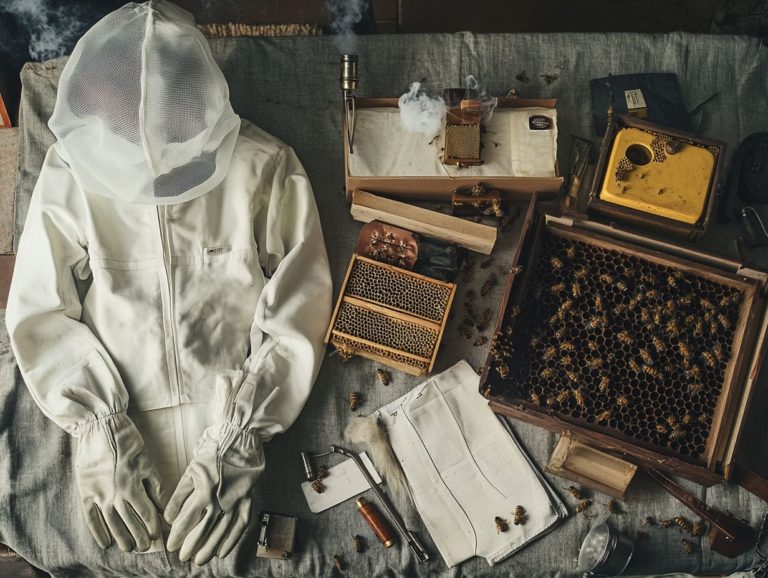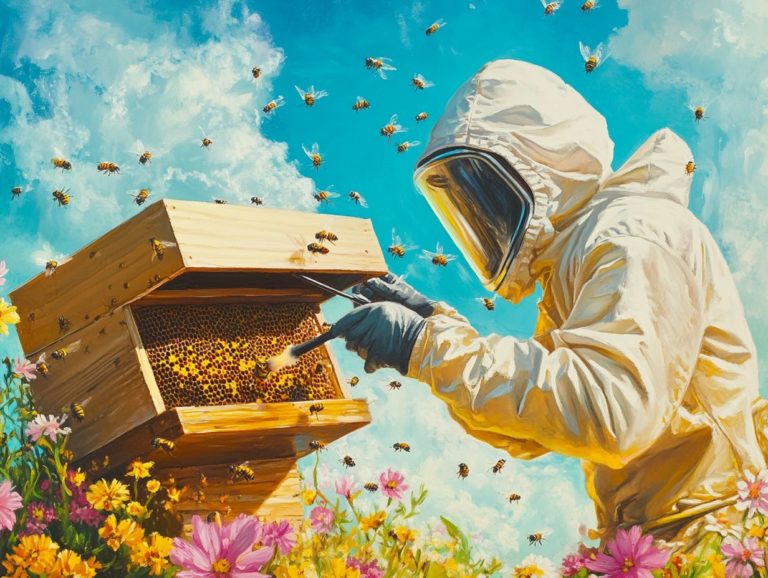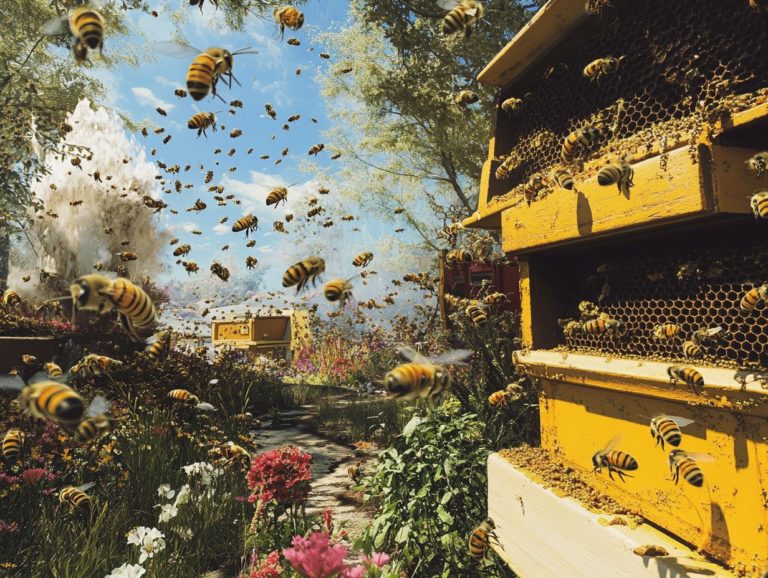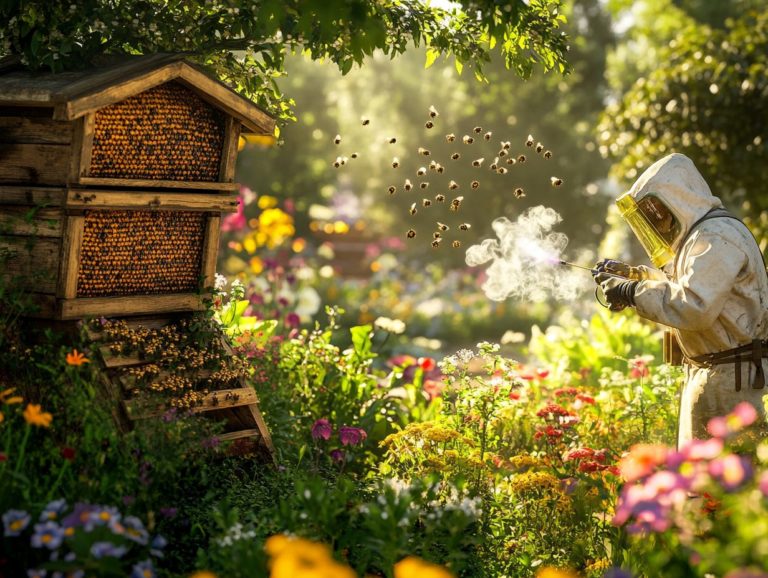Understanding Beekeeping Equipment Regulations
Beekeeping is not just a hobby; it s a rewarding adventure! It requires the right tools and a commitment to safety and sustainability, especially when facing challenges like the varroa mite.
From protective gear to hive components, selecting the appropriate tools, including hive boxes and mite boards, is essential for you as a beekeeper.
This article explores the diverse types of beekeeping equipment, the crucial regulations that govern their use, and the significance of compliance, which are essential for effective bee husbandry.
By adhering to these guidelines, you can protect your bees, bolster your business, and contribute positively to the environment, all while enriching your beekeeping experience and ensuring robust colony health.
Contents
- Key Takeaways:
- What is Beekeeping Equipment?
- Why are Regulations for Beekeeping Equipment Important?
- What are the Different Types of Beekeeping Equipment?
- What are the Regulations for Beekeeping Equipment?
- How to Ensure Compliance with Beekeeping Equipment Regulations?
- What Happens if Regulations for Beekeeping Equipment are not Followed?
- Frequently Asked Questions
- What are the regulations for beekeeping equipment?
- Why are there regulations for beekeeping equipment?
- What types of beekeeping equipment are regulated?
- How can I find out what rules apply to me?
- What happens if I don’t follow the rules for beekeeping equipment?
- Are there any exceptions to beekeeping equipment rules?
Key Takeaways:
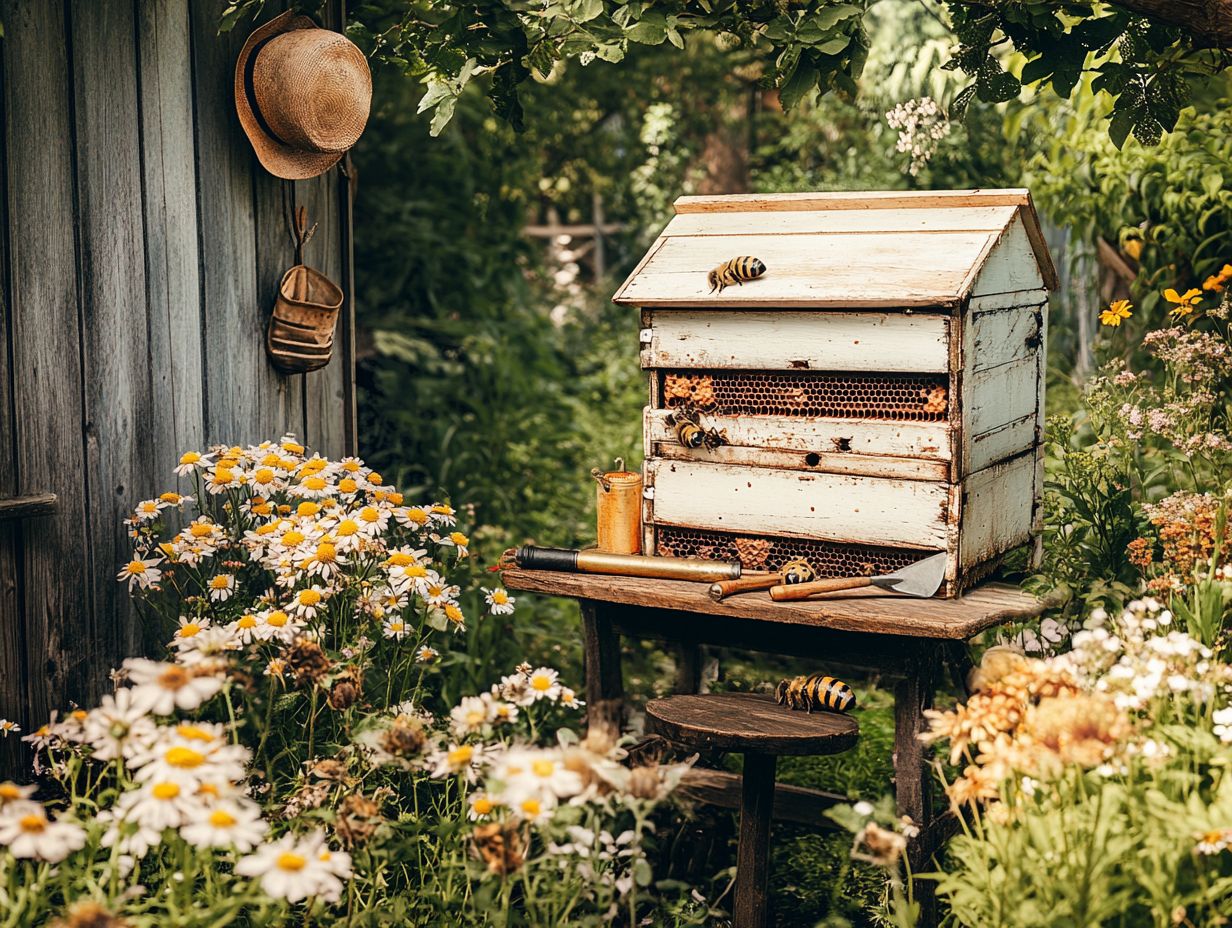
- Always check the latest regulations to keep your bees safe and your business thriving!
- Choose trusted suppliers for your equipment to ensure you get the best!
- Failure to follow regulations may result in fines, potential harm to bees and beekeepers, and negative effects on the beekeeping industry.
What is Beekeeping Equipment?
Beekeeping equipment includes all the tools needed to manage your beehives and care for your bee colonies. At the heart of this equipment is the Langstroth hive, a popular type of beehive that provides shelter and supports honey production.
You’ll also find essential items like entrance reducers, mite boards, and hive tools for effective pest management and hive inspections. Don t overlook your personal protection gear; it s essential for your safety as you dive into this exciting venture!
Why are Regulations for Beekeeping Equipment Important?
Regulations surrounding beekeeping equipment are essential for safeguarding the health and safety of both bees and beekeepers, especially given the contemporary challenges posed by bee diseases and pests like the varroa mite.
You can find these important regulations in resources such as the Federal Register and eCFR.gov. They serve to standardize practices and ensure that the beekeeping community adheres to critical safety protocols.
Grasping these regulations is imperative for maintaining robust colonies and protecting local ecosystems, all while championing sustainable beekeeping practices.
What are the Different Types of Beekeeping Equipment?
You ll find that various types of beekeeping equipment are essential for managing your apiary effectively. This includes protective gear for yourself, hive components that create an optimal environment for your bees, and harvesting tools that make honey extraction a breeze.
Protective gear, such as bee suits and gloves, is your first line of defense against stings while you work among the hives. The hive components, including the brood box vital for your colony’s growth and honey supers that capture honey during the nectar flow season, are equally important. Each tool you use plays a significant role in ensuring your success in beekeeping and honey production, making it crucial to source your equipment from reputable beekeeping supplies.
1. Protective Gear
Your beekeeping adventure begins with essential gear like a bee suit, gloves, and veils that offer comprehensive coverage against stings. Protective gear is an essential cornerstone of beekeeping, ensuring your safety while navigating the unpredictable nature of bees, which can sometimes be a bit defensive.
By donning the right protective gear, you not only enhance your own comfort but also help reduce stress for the bees. This creates a more harmonious working environment.
The significance of personal protection is paramount, especially if you’re new to the craft and learning the nuances of hive management. Plus these basics, you may want to consider specialized equipment like boots and hoods with integrated veils, which can significantly boost your safety and comfort levels.
The bee suit, typically crafted from lightweight fabric, acts as a barrier while allowing for breathability an absolute necessity during those warmer months. Your gloves should be long enough to cover your wrists completely, and it’s wise to select a pair that offers dexterity without compromising on protection.
Regular maintenance of your gear is crucial; routinely checking for any wear or gaps can help prevent those unwanted stings. Stay vigilant about your surroundings and the behavior of your bees, as this awareness can greatly influence the effectiveness of your protective attire.
2. Hive Components
Hive components are the backbone of your successful beekeeping operation, encompassing structures like the brood box, where your queen and her brood reside, and honey supers, specifically designed for honey production. In a Langstroth hive a popular type of beehive that allows bees to build their homes in removable boxes these elements work in harmony to create a thriving environment for your colony, facilitating efficient resource management.
The entrance reducer helps control hive access, while a queen excluder ensures that only worker bees can access the honey supers, optimizing your honey harvest without disturbing the brood. Proper ventilation is also imperative to maintain internal hive conditions.
Additional structures, such as the bottom board, provide essential support and ventilation, helping to maintain a healthy atmosphere inside the hive. Frames within the boxes allow your bees to construct their honeycomb, which is vital for storing both honey and pollen.
The overall internal layout is meticulously designed to encourage the bees’ natural behaviors like foraging and brood rearing, especially during periods of high nectar flow. Effective beekeeping hinges not only on these physical components but also on your understanding of their interactions, which ultimately influence colony health, productivity, and honey yield.
Without a solid grasp of these elements, managing your beehive could become a daunting challenge. It s essential to attend beekeeper workshops.
3. Harvesting Tools
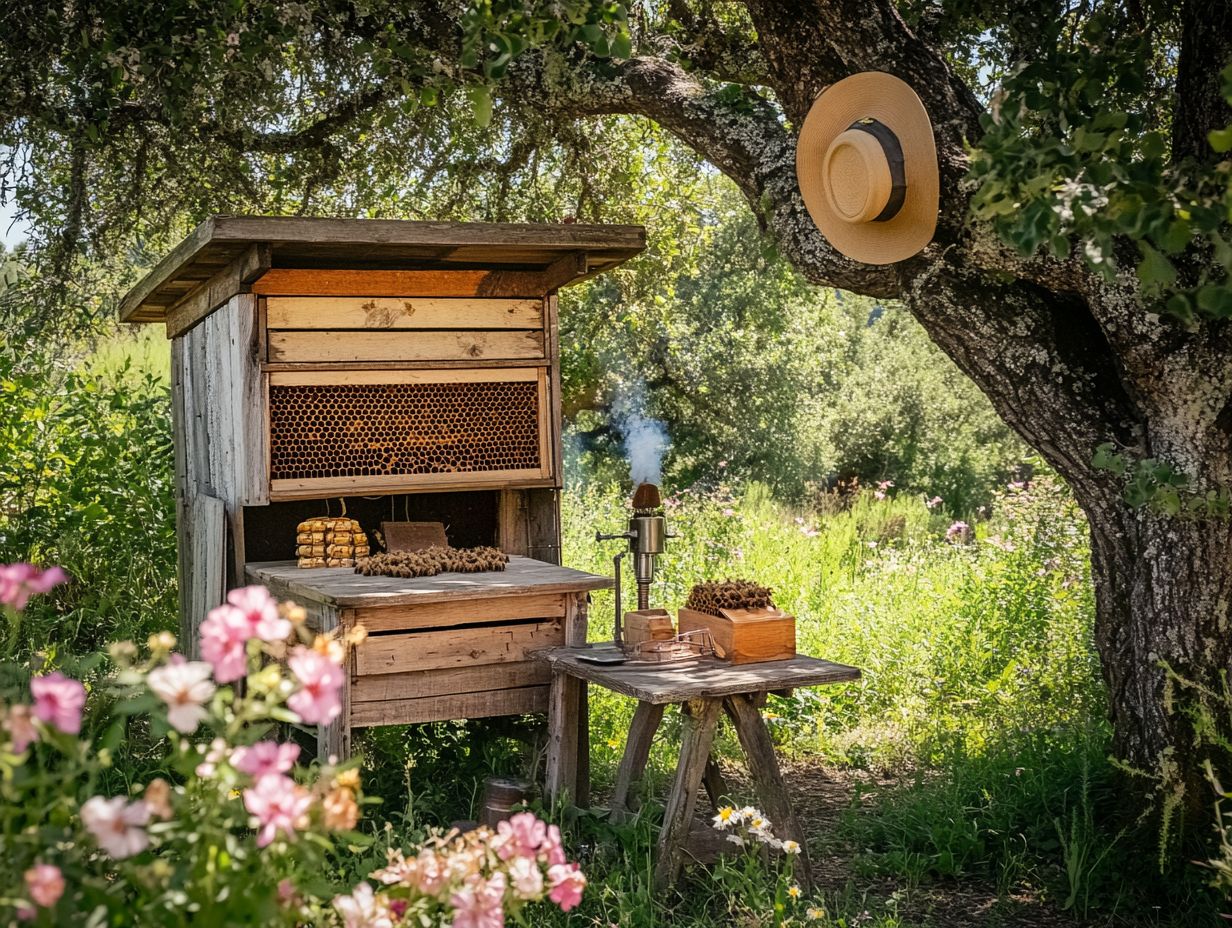
Harvesting tools are essential for you as a beekeeper during the honey extraction process, allowing you to collect honey efficiently while keeping the disruption to your bees to a minimum.
Key tools in your arsenal include the hive tool perfect for prying open boxes and managing frames and the bee brush, which lets you gently remove bees from honeycomb without causing them harm. It s crucial to master these tools for a successful honey harvest don t wait!
Preparing sugar water or syrup can benefit your bees during times of low nectar flow. You ll often find yourself using a honey extractor, whether manual or electric, to spin honey out of the frames without crushing the comb.
Remember, gentle handling of the bees throughout this process is very important; the less agitated they are, the smoother your extraction will go. Wearing protective gear like veils and gloves will allow you to work with confidence, and using smoke can help calm the bees, creating a more serene atmosphere.
By thoughtfully employing these best practices and tools, you can ensure a high-quality honey yield, which is vital for both your operations and the well-being of your bee colonies.
What are the Regulations for Beekeeping Equipment?
Beekeeping equipment regulations ensure your supplies meet safety and quality standards. This protects both you and your bees.
These regulations, typically published in the Federal Register, outline various requirements that include:
- Safety standards for the construction and maintenance of your equipment
- Quality standards that ensure durability and effectiveness
- Labeling requirements that provide vital information for your beekeeping endeavors
By following these standards, you protect your bees and ensure your beekeeping success!
1. Keep Your Bees Safe: Essential Safety Standards
Safety standards for beekeeping equipment are crucial to ensure that all tools and materials are safe for you and your bees. These standards guide the selection of materials for constructing hives and protective gear.
Regular inspections help ensure compliance with safety standards, significantly reducing the risks associated with equipment failure and potential harm to both your colonies and yourself.
Adhering to these safety standards minimizes the risk of disease transmission and contamination within your hives. Regulations govern the making of protective clothing, ensuring it is durable and provides adequate protection against stings. The materials used for hive construction must be non-toxic and environmentally sustainable, creating a healthy habitat for your bees.
Implementing rigorous inspection routines helps you promptly identify and address issues such as wear and tear or structural instability, safeguarding both the integrity of your hives and your well-being. By maintaining these standards, you foster a healthier ecosystem and promote responsible beekeeping practices beneficial for everyone involved.
2. Quality Matters: Essential Quality Standards
Quality standards for beekeeping supplies are vital for ensuring your equipment is both durable and effective. This enables you to maintain healthy colonies and produce honey confidently.
These standards cover key elements such as the materials used in construction, the design of hive components, and the overall functionality of tools like the hive tool and bee brush. Investing in high-quality supplies directly impacts the productivity of your hives and the well-being of the bees.
Durable materials reduce wear and tear, ensuring your tools withstand harsh environmental conditions over time. Thoughtfully designed equipment minimizes stress on your bee populations during handling, fostering a healthier colony environment.
Recognizing that investing in superior beekeeping equipment is a proactive strategy enhances your practices’ effectiveness and protects the vitality of bee populations essential contributors to our global ecosystems.
Call to Action: Check your equipment today to ensure compliance with these essential regulations and enhance your beekeeping practices!
3. Labeling Requirements
Labeling requirements for beekeeping equipment are essential for equipping you with vital information about the use, safety, and maintenance of your supplies. These regulations ensure that your equipment features key details, such as the manufacturer, safety warnings, and usage instructions, empowering you to make informed decisions.
Compliance with these labeling standards isn t just a legal obligation; it also enhances the safety and effectiveness of your beekeeping practices.
By adhering to these specific labeling standards, you can better evaluate the reliability and suitability of your tools and materials, ultimately helping you prevent mishaps and ensure the proper care of your colonies. Accurate labeling acts as a valuable conduit for information, enabling both newcomers and seasoned practitioners to make educated choices about which products best meet their needs.
In a field that demands precision and safety, these regulations serve as a guiding compass, creating a responsible beekeeping community that prioritizes the health and well-being of both bees and beekeepers.
How to Ensure Compliance with Beekeeping Equipment Regulations?
Ensuring compliance with beekeeping equipment regulations requires a proactive mindset, one that embraces a thorough understanding of both local and national regulations governing beekeeping practices. You should start by researching the specific requirements established by your state or regional authorities, as these can differ significantly.
It’s crucial to buy equipment from reputable sources that adhere to these regulations, ensuring you maintain compliance. Regular inspections of your equipment will also help you identify potential issues before they escalate into critical problems.
1. Research Local and National Regulations
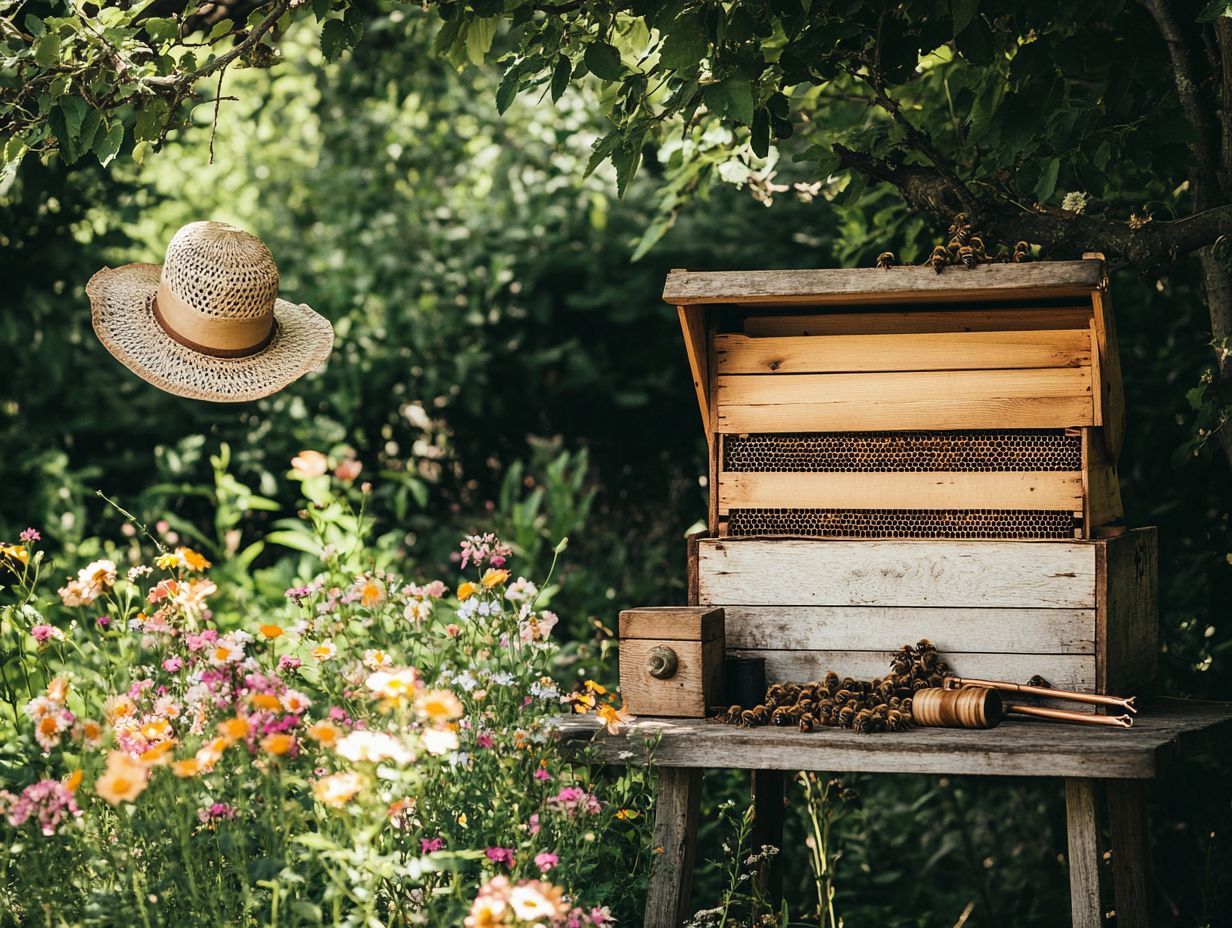
Researching local and national regulations is fundamental for you as a beekeeper to ensure compliance with applicable laws governing the management and equipment of your beekeeping endeavors. Your beekeeping success relies on understanding these important regulations related to health and safety, environmental considerations, and the welfare of bee populations.
By grasping these regulations, you can adapt your methods accordingly, which ultimately helps ensure the sustainability of your operations and the protection of your bees.
Keeping up with changing laws is vital for your beekeeping success. You can proactively engage with local agricultural extensions, attend workshops, or participate in forums where regulations are discussed.
Online resources, such as government websites or reputable beekeeping organizations, are invaluable for accessing up-to-date information. Connecting with fellow beekeepers can foster a supportive community where best practices for compliance are shared, ensuring that everyone involved is informed and equipped to make responsible decisions that reflect a commitment to the hive and its surrounding environment.
2. Purchase Equipment from Reputable Sources
Purchasing beekeeping equipment from reputable sources is essential for you to ensure compliance with regulations and maintain the health of your bee colonies. When you choose reliable suppliers, you gain access to products that meet established safety and quality standards, significantly reducing the risk of any equipment-related issues.
By prioritizing reputable sources, you can ensure that your supplies contribute positively to your apiary while adhering to necessary regulations. Investing in high-quality beekeeping supplies not only protects the wellbeing of your bees but also enhances your overall productivity and hive management.
As you select suppliers, be sure to consider those with positive reputations, verified customer reviews, and a commitment to ethical practices. Quality equipment is vital for your success in beekeeping, as it helps prevent disease, encourages strong colony growth, and facilitates efficient honey harvesting.
Additionally, comprehensive support from your suppliers can assist you in troubleshooting any issues that arise, ensuring you remain compliant and informed about the best practices in the industry.
3. Regularly Inspect and Maintain Equipment
Regularly inspecting and maintaining your beekeeping equipment is crucial for ensuring compliance with safety standards and quality requirements. This significantly impacts the well-being of your bee colonies. These inspections empower you to identify wear and tear or any potential issues that could jeopardize your equipment’s functionality, such as hive boxes, hive tools, and feeding supplements.
By prioritizing maintenance and timely repairs, you can uphold the health of your apiary and ensure your practices align with the rules you need to follow. Consistent upkeep helps your colonies thrive by protecting them from diseases and pests. Keeping your tools clean and in good repair minimizes the risk of cross-contamination and enhances the efficient operation of your hives.
Staying informed about best practices for equipment sanitation and regularly inspecting the safety features on all tools and devices you use is crucial for your success! By adopting proactive management strategies, you significantly enhance your chances of achieving successful yields and maintaining the delicate balance of your ecosystem, ultimately leading to a flourishing beekeeping operation.
What Happens if Regulations for Beekeeping Equipment are not Followed?
Neglecting the regulations surrounding beekeeping equipment can result in serious repercussions for you and your bee colonies, including fines and penalties, and even potential harm to the bees themselves. Non-compliance can lead to legal troubles that threaten your ability to continue beekeeping or, in some cases, result in a complete shutdown of your operations.
The stakes are higher than just individual penalties; disregarding these regulations could also have broader negative effects on the beekeeping industry and local ecosystems.
1. Fines and Penalties
Fines and penalties for violating regulations related to beekeeping equipment can vary significantly based on the severity of the infraction and the jurisdiction in which you operate. These financial repercussions serve as a deterrent for non-compliance and underscore the importance of adhering to established standards for equipment safety and quality. Understanding potential fines and penalties is essential for you to avoid unexpected costs and maintain your operations within the legal framework.
Non-compliance can lead to an array of penalties, ranging from monetary fines to the confiscation of your bees and equipment, all of which can severely impact your financial stability. A minor violation might result in a small fine, while more serious offenses, such as failing to implement proper disease management practices, could incur substantial penalties that threaten the viability of your entire operation.
Repeated infractions may escalate into higher fines or even the loss of your licenses, leading to significant operational disruptions. By familiarizing yourself with the intricate legal aspects of beekeeping regulations, you can make informed decisions that prevent legal issues and ensure continued compliance and success in your beekeeping endeavors.
2. Risk of Harm to Bees and Beekeepers
Neglecting regulations for beekeeping equipment can expose you to significant risks that endanger both your bees and your well-being. This is particularly true in terms of spreading bee diseases and ineffective pest management. Without adhering to proper equipment standards, your colonies may become vulnerable to pests like the varroa mite, a parasite that attacks bees and can wreak havoc on populations if not kept in check.
Your safety as a beekeeper is at risk when your equipment fails. Inadequate gear can lead to unwanted stings and potential allergic reactions. Proper use of personal protection gear like bee suits and gloves is essential.
Compromised equipment also creates a breeding ground for diseases such as American Foulbrood, a serious bacterial disease affecting bee larvae, and varroa mite. These can easily spread and put not just your individual colonies at risk but also threaten the health of the entire apiary community.
Following equipment regulations ensures your tools are effective and safe, ultimately promoting the overall health of your colonies. This includes regular hive inspections and using effective pest management strategies.
Investing in quality gear such as hive tools and protective clothing is essential for preventing infestations and illnesses. This highlights the crucial connection between bee health, equipment integrity, and the sustainability of your beekeeping practices. Using equipment like hive boxes, queen excluders, and internal feeders can significantly enhance your beekeeping operations.
3. Negative Impact on the Beekeeping Industry
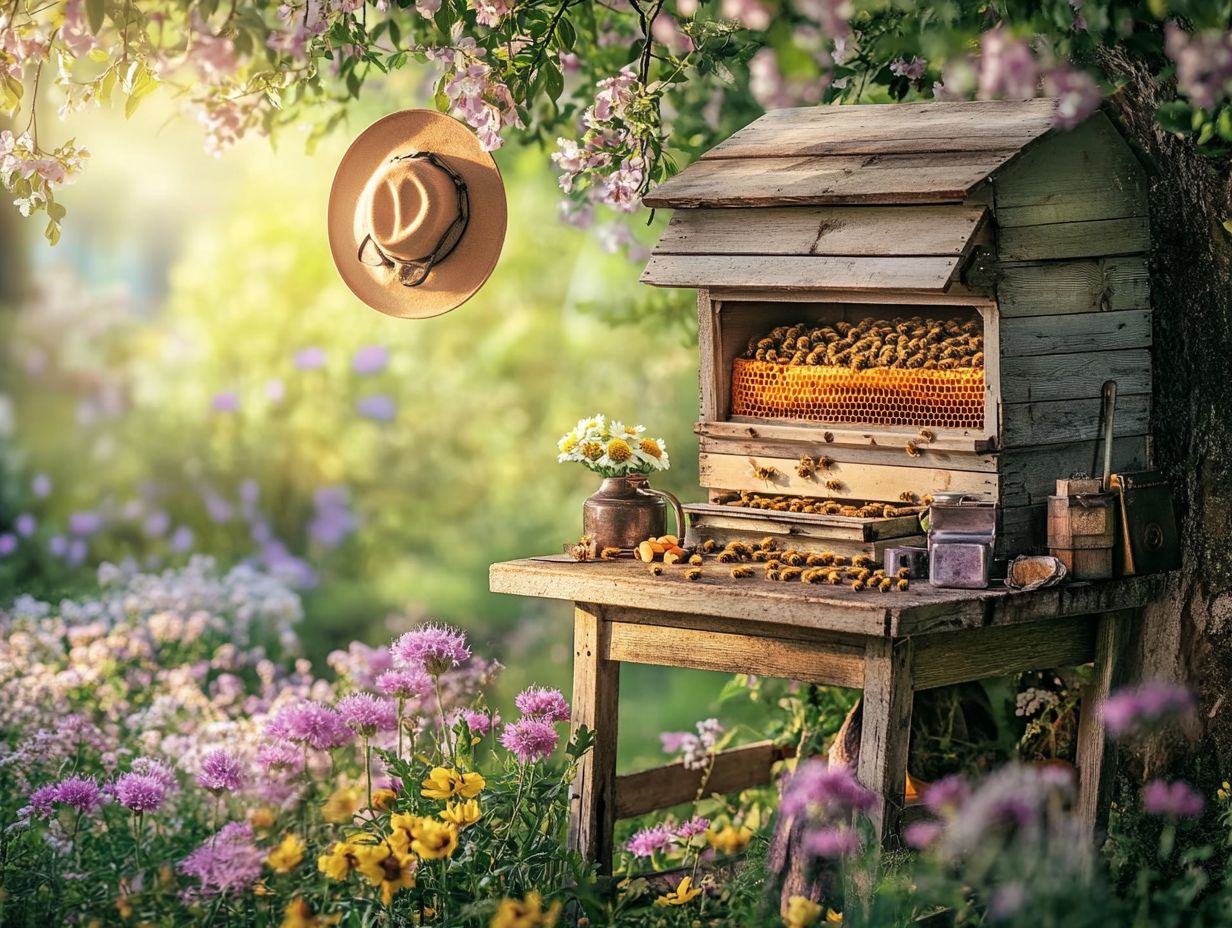
The entire beekeeping industry can face serious repercussions when regulations concerning equipment are overlooked. This can lead to a decline in colony health that can ripple through local ecosystems.
When you neglect compliance, it can erode public trust in beekeeping practices. This results in diminished support for sustainable efforts and ultimately affects honey production.
Disregarding these regulations not only puts your own operations at risk but also contributes to the broader challenges faced by the entire beekeeping community. This neglect can manifest in harmful ways, making your colonies more vulnerable to pests and diseases.
Such conditions can quickly decimate local bee populations and disrupt the crucial pollination services that agriculture and biodiversity rely on. The impact on environmental sustainability is profound; when bee colonies weaken, the delicate balance of the ecosystem is threatened, potentially leading to reduced crop yields and less diverse plant life.
As public awareness of environmental issues continues to rise, non-compliant beekeepers risk alienating consumers who prefer ethically sourced honey products. This shift in consumer preference can alter market dynamics for everyone involved in the industry, making adherence to regulations more important than ever.
Frequently Asked Questions
What are the regulations for beekeeping equipment?
Regulations can cover everything from the use of hive boxes and frame holders to feeding supplements and entrance reducers. Regulations for beekeeping equipment vary by location and can be found in local, state, or federal laws.
Researching and following these regulations is crucial for keeping your bees healthy and happy!
Why are there regulations for beekeeping equipment?
Regulations for beekeeping equipment are in place to protect bee health and prevent the spread of diseases and pests. They also ensure that the equipment used is safe for both the bees and the beekeeper.
What types of beekeeping equipment are regulated?
- Hives
- Frames
- Protective gear
- Tools
In addition to basic hives and frames, regulations often cover items like hive tools, queen excluders, and propolis traps. Proper ventilation and use of hive stands like cinder blocks can also be regulated. Some regulations may also cover the use of certain chemicals or medications in beekeeping.
How can I find out what rules apply to me?
Consult resources like FederalRegister.gov and eCFR.gov for detailed information on federal rules.
Start by researching local and state laws about beekeeping equipment. You can also contact local beekeeping groups for specific guidance.
What happens if I don’t follow the rules for beekeeping equipment?
Ignoring these rules can lead to fines or penalties. It can also harm your bees and affect your success as a beekeeper!
Are there any exceptions to beekeeping equipment rules?
Some areas may allow alternative methods like organic acids or sugar syrup feeding under certain conditions.
Small-scale or hobby beekeepers might have some exemptions. However, always check with local authorities to ensure you follow the applicable rules.

